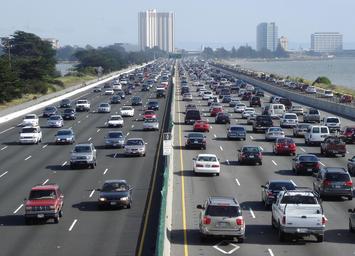
The mayor of San Diego wants to spend $177 billion expanding the region’s transit system in order to make San Diego like “Barcelona, Madrid, Paris.” Meanwhile, Barcelona, Madrid, and Paris are becoming more like U.S. cities, at least in terms of the transportation habits of their residents. Driving is the dominant form of travel in all European cities and is rebounding fast after pandemic lock-downs.
Of course, driving is rebounding even faster in the United States, according to INRIX estimates. Total driving at the end of June, the entire month of July, and the first week of August was more than it had been in the weeks before the pandemic. Of course, it was the middle of winter before the virus, but that’s still an impressive comeback.
Interestingly, that driving hasn’t brought congestion back to its pre-COVID levels. Morning rush-hour driving in most urban areas was only only around 70 to 80 percent of pre-shutdown levels while afternoon rush-hour driving was 80 to 90 percent, with afternoon levels exceeding 100 percent in just a couple of urban areas. As a result, rush-hour speeds are significantly higher than they were before the pandemic.
My interpretation of this is that a lot of people are working at home, so they aren’t driving at rush hour, but they are still driving at other times of the day. As I wrote last week, “people who work at home don’t necessarily drive less than people who commute by car — they just drive at other times of the day.”
Meanwhile, as I noted Monday, June transit ridership down nearly 70 percent. Transit advocates are telling themselves that riders will come back after the virus. A survey of San Francisco commuter-train riders found that 43 percent say they will ride transit after the pandemic is over as much as they did before. A survey of Philadelphia transit riders say they will come back to transit if they are allowed to socially distance themselves.
These numbers are presented as good news for transit. Get real: if only 43 percent to 55 percent of riders return, the results will be catastrophic for transit agencies. Meanwhile, other transit experts claim people will return to transit “because it’s cheap.” But it’s not: driving a used car or even an inexpensive new car can cost less than riding transit, especially if you have a passenger most of the time.
So now seems to be a bad time to be talking about spending billions on transit. Yet San Diego is not the only place that is considering such nonsense. This November, Austin voters will be asked to approve a huge property tax increase to pay for a $7 billion light-rail system. San Antonio voters will be asked to dedicate an existing sales tax that is now being spent on the city’s water supply on transit instead. I wonder how many San Antonians drink water vs. how many ride transit?
Both sales taxes and property taxes are regressive, yet they are the main ways transit agencies pay for their operations. In this age of social justice, it seems odd that people would support regressive taxes to subsidize transit.
Nationally, only 5.2 percent of people who earn under $25,000 a year take transit to work. In Austin and San Antonio, it is less than 4 percent; San Diego is just under 5 percent. That means we are using regressive taxes to force low-income people to pay for transit rides that 95 percent of them never take. That’s hardly socially just.
This piece first appeared on The Antiplanner.
Randal O'Toole (rot@ti.org) is a Cato Institute Senior Fellow working on urban growth, public land, and transportation issues. He is the author of numerous Cato papers and has also written for numerous other national journals and newspapers.
Photo credit: Minesweeper via Wikimedia under CC 3.0 License.












